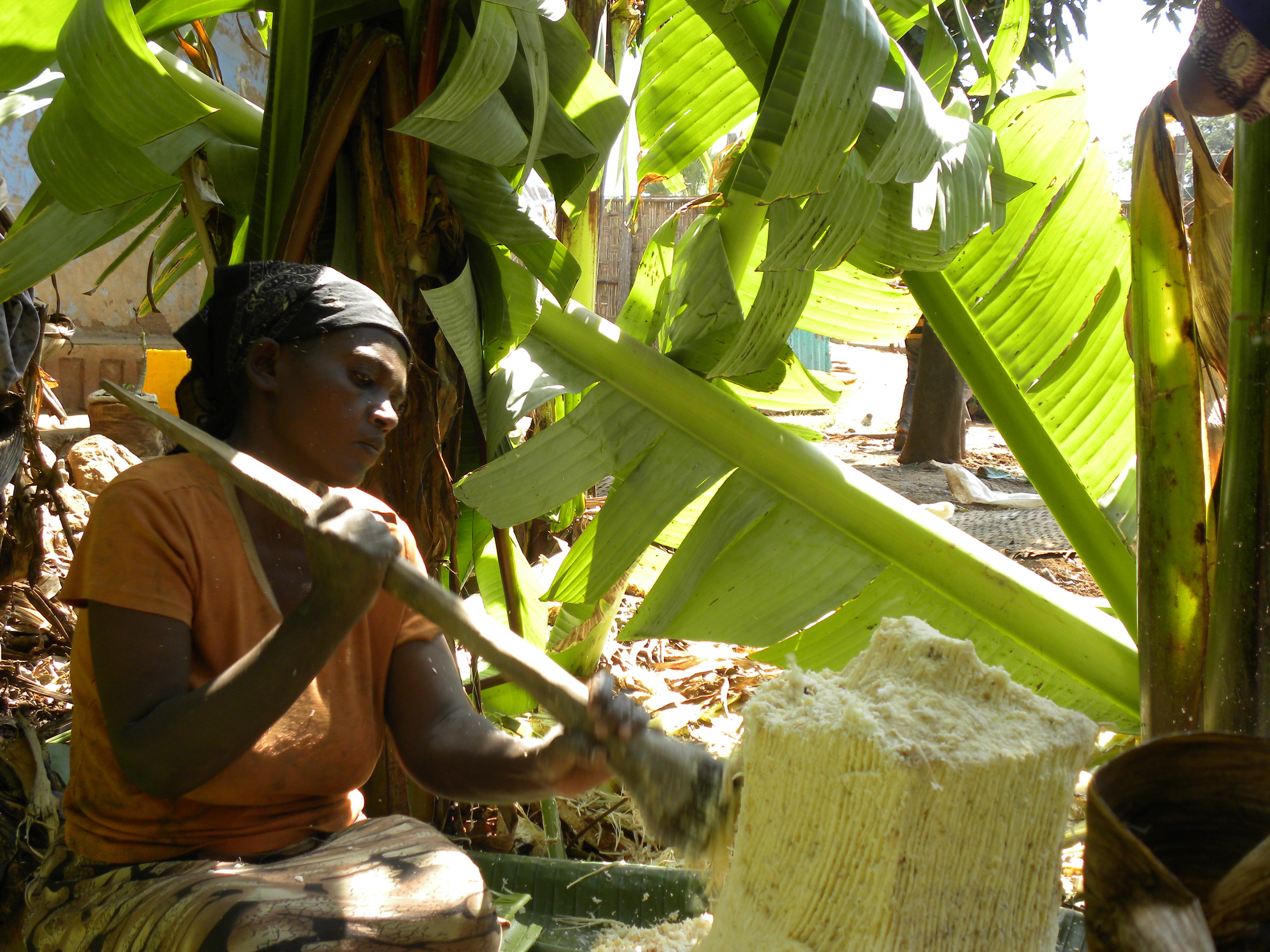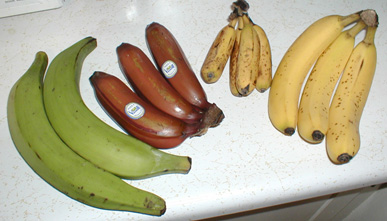|
Ensete
''Ensete'' is a genus of monocarpic flowering plants native plant, native to tropical regions of Africa and Asia. It is one of the three genera in the banana family, Musaceae, and includes the false banana or enset (''Ensete ventricosum, E. ventricosum''), an economically important food crop in Ethiopia. Taxonomy The genus ''Ensete'' was first described by Paul Fedorowitsch Horaninow (or Paul Fedorowitsch Horaninov, Horaninov, 1796–1865) in his ''Prodromus Monographiae Scitaminarum'' of 1862 in which he created a single species, ''Ensete edule''. However, the genus did not receive general recognition until 1947 when it was revived by Ernest Entwistle Cheesman, E. E. Cheesman in the first of a series of papers in the ''Kew Bulletin'' on the classification of the bananas, with a total of 25 species. Taxonomically, the genus ''Ensete'' has shrunk since Cheesman revived the taxon. Cheesman acknowledged that field study might reveal Synonym (taxonomy), synonymy and the most recen ... [...More Info...] [...Related Items...] OR: [Wikipedia] [Google] [Baidu] |
Ensete Ventricosum
''Ensete ventricosum'', commonly known as enset or ensete, Ethiopian banana, Abyssinian banana, pseudo-banana, false banana and wild banana, is a species of flowering plant in the banana family Musaceae. The domesticated form of the plant is cultivated only in Ethiopia, where it provides the staple food for approximately 20 million people. The name ''Ensete ventricosum'' was first published in the Kew Bulletin 1947, p. 101. Its synonyms include ''Musa arnoldiana'' De Wild., ''Musa ventricosa'' Welw. and ''Musa ensete'' Johann Friedrich Gmelin, J. F. Gmelin. In its wild form, it is native plant, native to the eastern edge of the Geography of Africa#Plateau region, Great African Plateau, extending northwards from South Africa through Mozambique, Zimbabwe, Malawi, Kenya, Uganda and Tanzania to Ethiopia, and west to the Congo, being found in high-rainfall forests on mountains, and along forested ravines and streams. Description Like bananas, ''Ensete ventricosum'' is a lar ... [...More Info...] [...Related Items...] OR: [Wikipedia] [Google] [Baidu] |
Ensete Gilletii
''Ensete'' is a genus of monocarpic flowering plants native to tropical regions of Africa and Asia. It is one of the three genera in the banana family, Musaceae, and includes the false banana or enset ('' E. ventricosum''), an economically important food crop in Ethiopia. Taxonomy The genus ''Ensete'' was first described by Paul Fedorowitsch Horaninow (or Horaninov, 1796–1865) in his '' Prodromus Monographiae Scitaminarum'' of 1862 in which he created a single species, ''Ensete edule''. However, the genus did not receive general recognition until 1947 when it was revived by E. E. Cheesman in the first of a series of papers in the ''Kew Bulletin'' on the classification of the bananas, with a total of 25 species. Taxonomically, the genus ''Ensete'' has shrunk since Cheesman revived the taxon. Cheesman acknowledged that field study might reveal synonymy and the most recent review of the genus by Simmonds (1960) listed just six. Recently the number has increased to seven as ... [...More Info...] [...Related Items...] OR: [Wikipedia] [Google] [Baidu] |
Ensete Homblei
''Ensete'' is a genus of monocarpic flowering plants native to tropical regions of Africa and Asia. It is one of the three genera in the banana family, Musaceae, and includes the false banana or enset ('' E. ventricosum''), an economically important food crop in Ethiopia. Taxonomy The genus ''Ensete'' was first described by Paul Fedorowitsch Horaninow (or Horaninov, 1796–1865) in his '' Prodromus Monographiae Scitaminarum'' of 1862 in which he created a single species, ''Ensete edule''. However, the genus did not receive general recognition until 1947 when it was revived by E. E. Cheesman in the first of a series of papers in the ''Kew Bulletin'' on the classification of the bananas, with a total of 25 species. Taxonomically, the genus ''Ensete'' has shrunk since Cheesman revived the taxon. Cheesman acknowledged that field study might reveal synonymy and the most recent review of the genus by Simmonds (1960) listed just six. Recently the number has increased to seven as th ... [...More Info...] [...Related Items...] OR: [Wikipedia] [Google] [Baidu] |
Ensete Superbum
''Ensete superbum'' is a species of banana from India. Distribution The plant is well-known from the Western Ghats, Anaimalai Hills, some other South Indian hills in Dindigul and other parts of the peninsular India. It has also been recorded from Jhadol and Ogna forest ranges in Rajasthan, North India. There are also reports of a similar species in Thailand, but it is yet to be formally described.Constantine, D. (1999) The Musaceae — an annotated list of the species of Ensete, Musa and MusellaWebsite nternet - Accessed on 11 June 2008/ref> Description Plants may grow up to 3,7 m (12 f) high, the pseudostem may be up to half the height with a swollen base of up to 2,5 m (8 ft) in circumference at the base. The leaves are bright green in on both sides with a deeply grooved and short petiole. The leaf sheaths are persistent at the base and leave closely set scars on the corm Corm, bulbo-tuber, or bulbotuber is a short, vertical, swollen, underground plant st ... [...More Info...] [...Related Items...] OR: [Wikipedia] [Google] [Baidu] |
Ensete Glaucum
''Ensete glaucum'', the snow banana, has also been classified as ''Musa nepalensis'', ''Ensete giganteum'', or ''Ensete wilsonii''. Distribution This gigantic monocarpic herbaceous plant is native to China, Nepal, India, Myanmar (Burma), Vietnam and Thailand. It grows from in elevation. Description ''Ensete glaucum'' has a thick, waxy with sometimes bluish tinge, solitary pseudostem. It grows larger than the Abyssinian Banana (''Ensete ventricosum''). Its leaves are long and wide. Cultivation and uses The plant is cultivated as an ornamental plant Ornamental plants or ''garden plants'' are plants that are primarily grown for their beauty but also for qualities such as scent or how they shape physical space. Many flowering plants and garden varieties tend to be specially bred cultivars th ..., for its unique swollen bulbous base and large leaves and is used to feed pigs in parts of China. In India the pulp of the fruit is eaten, considered highly medicinal, and given ... [...More Info...] [...Related Items...] OR: [Wikipedia] [Google] [Baidu] |
Banana
A banana is an elongated, edible fruit – botanically a berry – produced by several kinds of large treelike herbaceous flowering plants in the genus '' Musa''. In some countries, cooking bananas are called plantains, distinguishing them from dessert bananas. The fruit is variable in size, color and firmness, but is usually elongated and curved, with soft flesh rich in starch covered with a peel, which may have a variety of colors when ripe. It grows upward in clusters near the top of the plant. Almost all modern edible seedless ( parthenocarp) cultivated bananas come from two wild species – '' Musa acuminata'' and ''Musa balbisiana'', or hybrids of them. ''Musa'' species are native to tropical Indomalaya and Australia; they were probably domesticated in New Guinea. They are grown in 135 countries, primarily for their fruit, and to a lesser extent to make banana paper and textiles, while some are grown as ornamental plants. The world's largest producers of bananas ... [...More Info...] [...Related Items...] OR: [Wikipedia] [Google] [Baidu] |
Musaceae
Musaceae is a family of flowering plants composed of three genera with about 91 known species, placed in the order Zingiberales. The family is native to the tropics of Africa and Asia. The plants have a large herbaceous growth habit with leaves with overlapping basal sheaths that form a pseudostem making some members appear to be woody trees. In most treatments, the family has three genera, ''Musa'', '' Musella'' and ''Ensete''. Cultivated bananas are commercially important members of the family, and many others are grown as ornamental plants. Taxonomy The family has been practically universally recognized by taxonomists, although with differing circumscriptions. Older circumscriptions of the family commonly included the genera now included in Heliconiaceae and Strelitziaceae. The APG III system, of 2009 (unchanged from the APG system, 1998), assigns Musaceae to the order Zingiberales in the clade commelinids in the monocots. The oldest fossil evidence of the family is though ... [...More Info...] [...Related Items...] OR: [Wikipedia] [Google] [Baidu] |
Ensete Perrieri
''Ensete perrieri'', or the ''Madagascar banana'', is a species of banana exclusively found in western Madagascar. The Madagascar banana is listed as critically endangered because of deforestation and climate change. Some botanists believe that the Madagascar banana is a potential source of resistance to Panama disease, which wiped out the Gros Michel banana, and threatens the Cavendish banana, which is the main banana of international commerce. Description The Madagascar banana tree is a herbaceous tree. It loses all of its leaves in the dry season with only a pseudostem of leaf-sheaths remaining. A typical Madagascar banana tree is high, with a trunk swollen at the base into a thick tuber in circumference. The roots are white, cylindrical and thick. The stem is surrounded by persistent leaf sheaths and thus takes on the appearance of a large trunk swollen at its base. It measures, on average, in circumference at the collar, a little higher (at a distance of ), only a ... [...More Info...] [...Related Items...] OR: [Wikipedia] [Google] [Baidu] |
Ernest Entwistle Cheesman
Ernest Entwistle Cheesman (21 September 1898 Wood Green - 9 January 1983 Weybridge), was an English botanist noted for his work on the family Musaceae. He was the son of Charles Cheesman and Grace Lizzie Davies. About August 1936 he married Ellen Elizabeth B. Weston (1892-1966). Cheesman collected in Trinidad and Tobago in 1925-1937, working as professor of botany at the Trinidad ''Imperial College of Tropical Agriculture'' and publishing ''Flora of Trinidad and Tobago'' with R. O. Williams in 1929. He became interested in the cultivation of cocoa while in Trinidad and wrote a number of papers on the subject - *Cheesman E.E. 1935. ''The vegetative propagation of cocoa.'' Tropical Agriculture 12(9): 240-246. *Cheesman E.E. 1936. ''The vegetative propagation of cocoa. VII.- Root systems of cuttings.'' Page 7, plates 3 & 4 in Fifth Annual Report on Cocoa Research 1935, Trinidad. *Cheesman E.E. 1941. ''General notes on field experiments CRB1 to CRB6.'' Pages 4–11 in Tenth Annual ... [...More Info...] [...Related Items...] OR: [Wikipedia] [Google] [Baidu] |
List Of Ethiopian Dishes And Foods
This is a list of Ethiopian and Eritrean dishes and foods. Ethiopian cuisine, Ethiopian and Eritrean cuisines characteristically consists of vegetable and often very spicy meat dishes, usually in the form of ''wat (food), wat'' (also ''w'et'', ''wot'' or ''tsebhi''), a thick stew, served atop ''injera'', a large sourdough flatbread,Javins, Marie"Eating and Drinking in Ethiopia." Accessed July 2011. which is about in diameter and made out of fermented teff flour. People of Ethiopia, Ethiopians and People of Eritrea, Eritreans eat exclusively with their right hands, using pieces of ''injera'' to pick up bites of entrées and side dishes. Utensils are rarely used with Ethiopian and Eritrean cuisine. Ethiopian and Eritrean dishes and foods [...More Info...] [...Related Items...] OR: [Wikipedia] [Google] [Baidu] |




